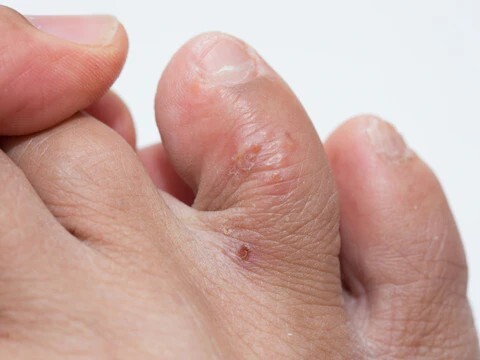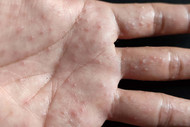Dyshidrotic Eczema: A Skincare Herbalist’s Guide to Root-Cause Relief and Herbal Healing
Posted by Brazen Bee Beauty on Apr 29th 2025
Dyshidrotic eczema—also known as pompholyx or vesicular eczema—is a particularly frustrating and often chronic form of eczema that uniquely affects the hands, fingers, toes, and soles of the feet. It presents as tiny, fluid-filled blisters that cause intense itching, burning, and sometimes pain. After the blisters dry, the skin may peel, crack, or thicken.



As a skincare herbalist, I understand this condition as not only a dermatological issue but also a signal from the body pointing toward deeper internal imbalances—often related to stress, liver congestion, immune reactivity, or toxic load. Thankfully, nature offers powerful allies for soothing symptoms and supporting healing both internally and externally.
Why the Hands and Feet?
Dyshidrotic eczema almost always targets the palms, sides of the fingers, and soles of the feet. These areas have a high concentration of sweat glands and tend to trap moisture, especially under gloves or socks. When coupled with stress or exposure to irritants (like nickel, detergents, or synthetic fabrics), this environment can trigger a flare.
Herbalist-Recommended Topical Treatment: The Healing Paste
For acute flares, I recommend applying a healing herbal paste I make with the following ingredients, all chosen for their specific actions that benefit dyshidrotic eczema:
Herbal Paste Ingredients and Their Benefits
1. French Green Clay (Illite Clay)
-
Detoxifies the skin by drawing out impurities, pus, and fluid from deep within the blisters
-
Reduces inflammation and soothes itch by absorbing excess moisture
-
Improves circulation to aid skin regeneration
2. Comfrey Root (Symphytum officinale)
-
Rich in allantoin, a compound that promotes cell proliferation and skin regeneration
-
Reduces inflammation and supports healing of cracked or peeling skin
-
Traditionally used to treat wounds and skin trauma
3. White Willow Bark (Salix alba)
-
Natural source of salicin, a precursor to salicylic acid, which helps relieve pain and inflammation
-
Mildly exfoliates and reduces swelling
-
Acts as a natural anti-itch and antimicrobial
4. Horse Chestnut (Aesculus hippocastanum)
-
Enhances microcirculation, reducing swelling and discomfort in the feet and hands
-
Contains aescin, a compound with anti-inflammatory and vascular-supporting properties
-
Helps with fluid retention and blister formation
5. Rosemary (Rosmarinus officinalis)
-
A stimulating herb that improves circulation and has antifungal and antibacterial properties
-
Helps reduce itching and prevent secondary infection
-
Supports the lymphatic system, promoting detox through the skin
How to Use the Herbal Paste
-
Add a few drips of water to the herbal mixture to create a paste
-
Apply a generous layer to clean skin on the affected hands, toes, or soles.
-
Let it sit for 20–30 minutes or until it begins to dry and pull slightly.
-
Rinse gently with lukewarm water and pat dry with a clean towel.
-
Follow up with Estick
-
Repeat at least twice daily during active flares for best results.
Final Thoughts from a Skincare Herbalist
Dyshidrotic eczema demands a twofold approach: calm the inflammation from the outside while supporting detoxification and immune balance from within. Herbal pastes like the one I offer, gives a gentle, effective way to work with the skin—not against it. As always, consistency and listening to your body’s responses are key.
As always, reach out for a skincare consultation.


